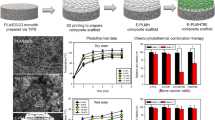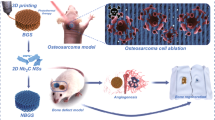Abstract
The insufficient of H2O2 restricts the efficacy of chemodynamic therapy in tumor microenvironment. Calcium peroxide (CaO2) is expected to solve this problem due to its H2O2-evolving ability. However, it prematurely decomposes in the moist air or water before reaching tumor site. In this study, zeolitic imidazolate framework-67 (ZIF-67) was in-situ grown on the surface of CaO2 to construct a pH-responsive CaO2@ZIF-67 system and then incorporated into poly-L-lactic acid (PLLA) to prepare PLLA/CaO2@ZIF-67 scaffold by selective laser sintering technology. On the one hand, ZIF-67 is used as a chemodynamic therapy agent due to the release of cobalt ions after degradation. On the other hand, ZIF-67 can serve as protective layers to prevent premature decomposition of CaO2 due to its hydrophobic properties, and then CaO2 is exposed and reacts with water to form H2O2 after the pH-responsive degradation of ZIF-67 under tumor acidic microenvironment. Results showed that the PLLA/CaO2@ZIF-67 scaffold could sustainedly produce H2O2 under acidic pH and achieve 84.64% antitumor ratio against MG-63 cells. In addition, the scaffold also promoted proliferation and osteogenic differentiation of mouse bone marrow mesenchymal stem cells due to the release of calcium ions. The prepared PLLA/CaO2@ZIF-67 scaffold with chemodynamic antitumor and osteogenic effects has great potential to treat tumorous bone defect.







Similar content being viewed by others
References
Jia CY, Guo YX, Wu FG (2022) Chemodynamic therapy via fenton and fenton-like nanomaterials: strategies and recent advances. Small 18(6):2103868. https://doi.org/10.1002/smll.202103868
Wang XW, Zhong XY, Liu Z, Cheng L (2022) Recent progress of chemodynamic therapy-induced combination cancer therapy. Nano Today 35:100946. https://doi.org/10.1016/j.nantod.2020.100946
Meng XY, Zhang XZ, Liu M, Cai B, He NY, Wang ZF (2020) Fenton reaction-based nanomedicine in cancer chemodynamic and synergistic therapy. Appl Mater Today 21:100864. https://doi.org/10.1016/j.apmt.2020.100864
Cao W, Jin MY, Yang K, Chen B, Xiong MM, Li X, Cao GD (2021) Fenton/Fenton-like metal-based nanomaterials combine with oxidase for synergistic tumor therapy. J Nanobiotechnol 19(1):1–35. https://doi.org/10.1016/j.apmt.2020.100864
Li SL, Jiang P, Jiang FL, Liu Y (2021) Recent advances in nanomaterial-based nanoplatforms for chemodynamic cancer therapy. Adv Funct Mater 31(22):2100243. https://doi.org/10.1002/adfm.202100243
Yang ML, Shuai Y, Yang YW, Zeng D, Peng SP, Tian ZJ, Shuai CJ (2022) In situ grown rare earth lanthanum on carbon nanofibre for interfacial reinforcement in Zn implants. VIRTUAL PHYS PROTOTY 17(3):700–717. https://doi.org/10.1080/17452759.2022.2053929
Shuai C, Yuan X, Shuai Y, Qian G, Yao J, Xu W, Peng S,Yang W (2022) Nitrogen-doped carbon-ZnO heterojunction derived from ZIF-8: a photocatalytic antibacterial strategy for scaffold. Mater Today Nano 18:100210. https://doi.org/10.1016/j.mtnano.2022.100210
Yang YW, Zan J, Shuai Y et al (2022) in situ growth of a metal-organic framework on graphene oxide for the chemo-photothermal therapy of bacterial infection in bone repair. ACS Appl Mater Inter. https://doi.org/10.1021/acsami.2c04841
Tang ZM, Liu YY, He MY, Bu WB (2019) Chemodynamic therapy: tumour microenvironment-mediated Fenton and Fenton-like reactions. Angew Chem Int Edit 58(4):946–956. https://doi.org/10.1002/anie.201805664
Lin LS, Song JB, Song L et al (2018) Simultaneous Fenton-like ion delivery and glutathione depletion by MnO2-based nanoagent to enhance chemodynamic therapy. Angew Chem Int Edit 130(18):4996–5000. https://doi.org/10.1002/anie.201712027
Zhang C, Bu W, Ni D et al (2016) Synthesis of iron nanometallic glasses and their application in cancer therapy by a localized Fenton reaction. Angew Chem Int Edit 128(6):2141–2146. https://doi.org/10.1002/anie.201510031
Huo MF, Wang LY, Chen Y, Shi JL (2017) Tumor-selective catalytic nanomedicine by nanocatalyst delivery. Nat Commun 8(1):1–12. https://doi.org/10.1038/s41467-017-00424-8
Gao ST, Jin Y, Ge K et al (2019) Self-supply of O2 and H2O2 by a Nanocatalytic medicine to enhance combined chemo/Chemodynamic therapy. Adv Sci 6(24):1902137. https://doi.org/10.1002/advs.201902137
Tang ZM, Liu YY, Ni DL et al (2020) Biodegradable nanoprodrugs:“delivering” ROS to cancer cells for molecular dynamic therapy. Adv Mater 32(4):1904011. https://doi.org/10.1002/adma.201904011
Liu B, Bian YL, Liang S et al (2021) One-step integration of tumor microenvironment-responsive calcium and copper peroxides nanocomposite for enhanced chemodynamic/ion-interference therapy. ACS Nano 16(1):617–630. https://doi.org/10.1021/acsnano.1c07893
Trachootham D, Alexandre J, Huang P (2009) Targeting cancer cells by ROS-mediated mechanisms: a radical therapeutic approach? Nat Rev Drug Discov 8(7):579–591. https://doi.org/10.1038/nrd2803
He CC, Zhang XJ, Xiang GY (2020) Nanoparticle facilitated delivery of peroxides for effective cancer treatments. Biomater Sci UK 8(20):5574–5582. https://doi.org/10.1039/d0bm01265c
Dong SM, Dong YS, Liu B et al (2022) Guiding transition metal-doped hollow cerium tandem nanozymes with elaborately regulated multi-enzymatic activities for intensive chemodynamic therapy. Adv Mater 34(7):2107054. https://doi.org/10.1002/adma.202107054
He CC, Zhang XJ, Chen C et al (2021) A solid lipid coated calcium peroxide nanocarrier enables combined cancer chemo/chemodynamic therapy with O2/H2O2 self-sufficiency. Acta Biomater 122:354–364. https://doi.org/10.1016/j.actbio.2020.12.036
Liu CH, Cao Y, Cheng YR, Wang DD, Xu TL, Su L, Zhang XJ, Dong HF (2020) An open source and reduce expenditure ROS generation strategy for chemodynamic/photodynamic synergistic therapy. Nat Commun 11(1):1–9. https://doi.org/10.1038/s41467-020-15591-4
Chu SL, Shi XL, Tian Y, Gao FX (2022) pH-Responsive polymer nanomaterials for tumor therapy. Front Oncol 12. https://doi.org/10.3389/fonc.2022.855019
Deng F, Wu P, Qian GW, Shuai Y, Zhang LM, Peng SP, Shuai CJ, Wang GY (2022) Silver-decorated black phosphorus: a synergistic antibacterial strategy. Nanotechnology 33(24):245708. https://doi.org/10.1088/1361-6528/ac5aee
Qi FW, Gao XW, Shuai Y, Peng SP, Deng YW, Yang S, Yang YW, Shuai CJ (2022). Magnetic-driven wireless electrical stimulation in a scaffold. Compos Part B Eng 237:109864. https://doi.org/10.1016/j.compositesb.2022.109864
Qian JF, Sun FA, Qin LZ (2012) Hydrothermal synthesis of zeolitic imidazolate framework-67 (ZIF-67) nanocrystals. MATER LETT 82:220–223. https://doi.org/10.1016/j.matlet.2012.05.077
Zhong GH, Liu DX, Zhang JY (2018) The application of ZIF-67 and its derivatives: adsorption, separation, electrochemistry and catalysts. J Mater Chem A 6(5):1887–1899. https://doi.org/10.1039/c7ta08268a
Feng XH, Carreon MA (2015) Kinetics of transformation on ZIF-67 crystals. J Cryst Growth 418:158–162. https://doi.org/10.1016/j.jcrysgro.2015.02.064
Lashgari SM, Yari H, Mahdavian M, Ramezanzadeh, B, Bahlakeh, G, Ramezanzadeh, M (2021) Application of nanoporous cobalt-based ZIF-67 metal-organic framework (MOF) for construction of an epoxy-composite coating with superior anti-corrosion properties. Corros Sci 178:109099. https://doi.org/10.1016/j.corsci.2020.109099
Guo XL, Xing TT, Lou YB, Chen JX (2016) Controlling ZIF-67 crystals formation through various cobalt sources in aqueous solution. J Solid State Chem 235:107–112. https://doi.org/10.1016/j.jssc.2015.12.021
Jiang Y, Lu Y, Lei LL, et al (2021) Near-infrared light-triggered synergistic antitumor therapy based on hollow ZIF-67-derived Co3S4-indocyanine green nanocomplex as a superior reactive oxygen species generator. Mat Sci Eng C Mater 130:112465. https://doi.org/10.1016/j.msec.2021.112465
Ma YS, Xu HH, Sun B, Du SL, Cui S, Zhang L, Ding N, Yang DZ (2021) pH-responsive oxygen and hydrogen peroxide self-supplying nanosystem for photodynamic and chemodynamic therapy of wound infection. Acs Appl Mater Inter 13(50):59720–59730. https://doi.org/10.1021/acsami.1c19681
Shuai CJ, Yang F, Shuai Y, Peng SP, Chen SJ, Deng YW, Feng P (2022) Silicon dioxide nanoparticles decorated on graphene oxide nanosheets and their application in poly (L-lactic acid) scaffold. J Adv Res. https://doi.org/10.1016/j.jare.2022.08.017
Gao CD, Zeng ZH, Peng SP, Shuai CJ (2022) Magnetostrictive bulk Fe-Ga alloys prepared by selective laser melting for biodegradable implant applications. Mater Design 220:110861. https://doi.org/10.1016/j.matdes.2022.110861
Shuai CJ, Wang ZC, Peng SP, Shuai Y, Chen YW, Zeng D, Feng P (2022) Water-responsive shape memory thermoplastic polyurethane scaffolds triggered at body temperature for bone defect repair. Mater Chem Front 6(11):1456–1469. https://doi.org/10.1039/d1qm01635k
Shuai CJ, Chen X, He CX, Qian GW, Shuai Y, Peng SP, Deng YW, Yang WJ (2022) Construction of magnetic nanochains to achieve magnetic energy coupling in Scaffold. Biomater Res 26(1). https://doi.org/10.1186/s40824-022-00278-2
Oladapo BI, Zahedi SA, Ismail SO, Omigbodun FT, Bowoto OK, Olawumi MA, Muhammad MA (2020) 3D printing of PEEK–cHAp scaffold for medical bone implant. Bio Des Manuf 4(1):44–59. https://doi.org/10.1007/s42242-020-00098-0
Silva EPE, Huang BY, Helaehil JV et al (2021) In vivo study of conductive 3D printed PCL/MWCNTs scaffolds with electrical stimulation for bone tissue engineering. Bio Des Manuf 4(2):190–202. https://doi.org/10.1007/s42242-020-00116-1
Feng P, Shen SP, Yang LYM, Kong Y, Yang S, Shuai CJ (2022) Vertical and uniform growth of MoS2 nanosheets on GO nanosheets for efficient mechanical reinforcement in polymer scaffold. Virtual Phys Prototy 18(1):e2115384. https://doi.org/10.1080/17452759.2022.2115384
Qian YJ, Zhang J, Zhang YL, Chen JB, Zhou XF (2016) Degradation of 2, 4-dichlorophenol by nanoscale calcium peroxide: implication for groundwater remediation. Sep Purif Technol 166:222–229. https://doi.org/10.1016/j.seppur.2016.04.010
Yan SL, Kim M, Salley SO, Ng KYS (2009) Oil transesterification over calcium oxides modified with lanthanum. Appl Catal A Gen 360(2):163–170. https://doi.org/10.1016/j.apcata.2009.03.015
Zeglinski J, Piotrowski GP, Piękos R (2006) A study of interaction between hydrogen peroxide and silica gel by FTIR spectroscopy and quantum chemistry. J Mol Struct 794(1–3):83–91. https://doi.org/10.1016/j.molstruc.2006.01.043
Wu JR, Zhang ZJ, Qiao CX, Yi CF, Xu ZS, Chen TY, Dai XF (2021) Synthesis of monodisperse ZIF-67@CuSe@PVP nanoparticles for pH-responsive drug release and photothermal therapy. Acs Biomater Sci Eng 8(1):284–292. https://doi.org/10.1021/acsbiomaterials.1c01124
Ni M, Ratner BD (2008) Differentiating calcium carbonate polymorphs by surface analysis techniques—an XPS and TOF-SIMS study. Surf Interface Anal 40(10):1356–1361. https://doi.org/10.1002/sia.2904
Wang ZP, Zhang YG, Tan ZC, Li QH (2018) A wet process for oxidation-absorption of nitric oxide by persulfate/calcium peroxide. Chem Eng J 350:767–775. https://doi.org/10.1016/j.cej.2018.05.145
Qin JN, Wang SB, Wang XC (2017) Visible-light reduction CO2 with dodecahedral zeolitic imidazolate framework ZIF-67 as an efficient co-catalyst. Appl Catal B Environ 209:476–482. https://doi.org/10.1016/j.apcatb.2017.03.018
Niu YQ, Galluzzi M, Deng FM, et al (2022) A biomimetic hyaluronic acid‐silk fibroin nanofiber scaffold promoting regeneration of transected urothelium. Bioeng Transl Med 7(2):e10268. https://doi.org/10.1002/btm2.10268
Zhang YB, Liu XC, Zeng LD, Zhang J, Zuo JL, Zou J, Ding JX, Chen XS (2019) Polymer fiber scaffolds for bone and cartilage tissue engineering. Adv Funct Mater 29(36):1903279. https://doi.org/10.1002/adfm.201903279
Li YC, Lin ZY, Wang XY, et al (2021) High-hydrophobic ZIF-8@ PLA composite aerogel and application for oil-water separation. Sep Purif Technol 270:118794. https://doi.org/10.1016/j.seppur.2021.118794
Torii S, Kurihara A, Li XY, Yasumoto KI, Sogawa K (2011) Inhibitory effect of extracellular histidine on cobalt-induced HIF-1α expression. J Biochem 149(2):171–176. https://doi.org/10.1093/jb/mvq129
Qian GW, Wen TC, Shuai Y, Wu XT, Zeng ZK, Peng SP, Shuai CJ (2022) Photothermal and photodynamic effects of g-C3N4 nanosheet/Bi2S3 nanorod composites with antibacterial activity for tracheal injury repair. Acs Appl Nano Mater. https://doi.org/10.1021/acsanm.2c03569
Qi FW, Wang ZH, Shuai Y, Peng SP, Shuai CJ (2022) Sr2+ sustained release system augments bioactivity of polymer scaffold. Acs Appl Polym Mater 4(4):2691–2702. https://doi.org/10.1021/acsapm.2c00024
Nakamura S, Matsumoto T, Sasaki JI, Egusa H, LEE KY, Nakano T, Sohmura T, Nakahira A, (2010) Effect of calcium ion concentrations on osteogenic differentiation and hematopoietic stem cell niche-related protein expression in osteoblasts. Tissue Eng Pt A 16(8):2467–2473. https://doi.org/10.1089/ten.tea.2009.0337
Seol YJ, Park JY, Jung JW, Jang J, Girdhari R, Kim SW, Cho DW (2014) Improvement of bone regeneration capability of ceramic scaffolds by accelerated release of their calcium ions. Tissue Eng Pt A 20(21–22):2840–2849. https://doi.org/10.1089/ten.tea.2012.0726
Fazeli N, Arefian E, Irani S, Ardeshirylajimi A, Seyedjafari E (2021) 3D-printed PCL scaffolds coated with nanobioceramics enhance osteogenic differentiation of stem cells. ACS Omega 6(51):35284–35296. https://doi.org/10.1021/acsomega.1c04015
Acknowledgements
This study was supported by the following funds: (1) The Natural Science Foundation of China (51935014, 52165043, 52105352, 82072084, 81871498); (2) JiangXi Provincial Natural Science Foundation of China (2020ACB214004, 20202BAB214011); (3) The Provincial Key R & D Projects of Jiangxi (20201BBE51012); (4) The Project of State Key Laboratory of High Performance Complex Manufacturing; (5) High-level Talents Scientific Research Initiation Project of Jiangxi University of Science and Technology (205200100487); and (6) Science and Technology Research Project of Education Department of Jiangxi Province (GJJ200863); (7) The Natural Science Foundation of China (81960880); (8) Guangdong Province Higher Vocational Colleges & Schools Pearl River Scholar Funded Scheme (2018); (9) Technology Innovation Platform Project of Shenzhen Institute of Information Technology 2020 (PT2020E002).
Author information
Authors and Affiliations
Corresponding authors
Ethics declarations
Conflict of interest
The authors declare that they have no known competing financial interests or personal relationships that could have appeared to influence the work reported in this paper.
Additional information
Handling Editor: Annela M. Seddon.
Publisher's Note
Springer Nature remains neutral with regard to jurisdictional claims in published maps and institutional affiliations.
Rights and permissions
Springer Nature or its licensor (e.g. a society or other partner) holds exclusive rights to this article under a publishing agreement with the author(s) or other rightsholder(s); author self-archiving of the accepted manuscript version of this article is solely governed by the terms of such publishing agreement and applicable law.
About this article
Cite this article
Qian, G., Wang, J., Yang, L. et al. A pH-responsive CaO2@ZIF-67 system endows a scaffold with chemodynamic therapy properties. J Mater Sci 58, 1214–1228 (2023). https://doi.org/10.1007/s10853-022-08103-w
Received:
Accepted:
Published:
Issue Date:
DOI: https://doi.org/10.1007/s10853-022-08103-w




